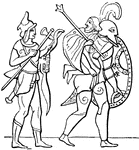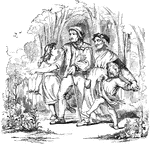Clipart tagged: ‘walking stick’

Leaf Insect
Walking Sticks and Leaf Insects lead a sluggish life among the branches of shrubs, living on the young…

Man with Hat and Cane
An illustration of a man wearing a black top hat and holding a cane in his left hand.

Praying Mantis
The praying mantis is so called from the attitude which it assumes when it is watching for its prey.…

Jesus Appears on the Road to Emmaus
"And behold, two of them were going that very day to a village named Emmaus, which was threescore furlongs…

Sceptrum
"Sceptrum, which originally denoted a simple staff or walking stick, was emblematic of station and authority.…

Cane Stripper
A cane is a long, straight wooden stick, generally of bamboo, Malacca (rattan) or some similar plant,…

Walking Stick
Walking sticks lead a sluggish life among the branches of shrubs, living on the young shoots. Their…

People in the Woods
A man, an older woman, and two children walk past a fence at the edge of a wooded area.



